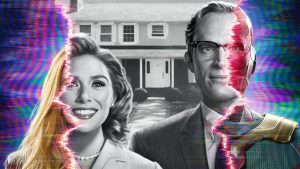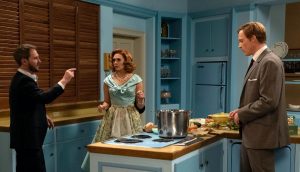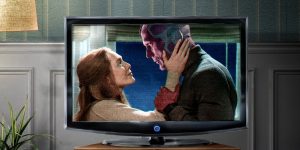SPOILERS AHEAD FOR WANDAVISION!
A year’s worth of quarantines and COVID-19 delays has changed us all, Marvel Studios’ classic formula and release date calendar included. Thus, WandaVision, originally slated to follow two more traditional Marvel installments (Black Widow and The Falcon And The Winter Soldier) onto the scene, is now kickstarting the MCU’s fourth phase of movies and Disney+ streaming series’. It’s a bold and potentially risky move: WandaVision is the kind of experimental property that Disney was probably afraid to lead with, due to its, shall we say, zanier qualities.

But as the MCU expands across multiple new mediums and genres, WandaVision probably offers the most authentic taste of what’s to come in the near future. Refreshingly unpredictable, quirky, and a bit more mature in tone than what we’ve come to expect from Marvel, the series’ first two episodes released this morning offer up a complex yet intoxicating concoction – blending the charm of retro black-and-white sitcoms with a dash of chilling psychological horror. Ironically, the only ingredient absent from the recipe is superheroes – and I’m okay with that.
With no Avengers running amuck, and with both Wanda Maximoff (Elizabeth Olsen) and Vision (Paul Bettany) trying to hide their supernatural origins from their neighbors, WandaVision‘s quaint suburban utopia is perfectly normal in every way, at least at first: and only hints of the larger cinematic universe are able to bleed through, mostly via brief, jarring, infomercial segments that interrupt each episode about halfway through, advertising some bizarre product with a hidden MCU connection – a Stark Industries toaster, which refers back to Wanda’s own complicated history with Tony Stark, and to Vision’s famous comics nickname; and a classy Swiss wristwatch named for Wanda’s old handler, Baron Von Strucker, and bearing a small, sinister, HYDRA logo.
But for the most part, we’re simply following Wanda and Vision’s day-to-day misadventures in the picturesque town of Westview, as if we were being dropped randomly into the middle of actual sitcoms. The first two episodes span two decades of television history – the first set in the 50’s, with a familiar aesthetic borrowed from The Dick Van Dyke Show and I Love Lucy, and the second in the 60’s, with cute nods to Bewitched: including a near-identical animated opening sequence and some suspiciously witchy behavior. Each episode comes with a new theme song written by Frozen songwriting duo Kristen-Anderson Lopez and Robert Lopez, but the cast of characters remains the same, their ages and appearances largely unchanged even as they advance rapidly through time.
Elizabeth Olsen is at the top of her game, bringing out the best version of Wanda Maximoff yet with the help of extremely well-written dialogue and witty jokes that land well more often than not (the live audience laughter is give-or-take, though it works with the setting). Olsen has great comedic timing, and, crucially, all the charisma and earnestness of the real-life sitcom heroines from this era. She finds opportune moments to subtly channel the sophistication of The Dick Van Dyke Show‘s Mary Tyler Moore, the casual confidence of Bewitched‘s Elizabeth Montgomery, and the unbridled campiness of I Dream Of Jeannie‘s Barbara Eden, depending on what any given scene requires – but her performance is entirely her own, and never crosses the line into parody. Paul Bettany, meanwhile, lends a surprising amount of physical comedy and slapstick humor to the series, as well as his character’s signature brand of sardonic wit. Combined, the duo are more compelling and more naturally romantic (I’d even go so far as to say “adorable”) than we’ve ever seen them to date. With the series jumping into the 50’s setting right off the bat and providing no explanation for why or how two characters last seen in the modern world (one of whom even died – twice) are now living in an oldschool sitcom, Olsen and Bettany’s relatable performances act as necessary anchors for the audience – the couple seem just as unsure and unsettled as we all are, but do their best to ease into Westview’s flow without making a stir because (a) they don’t really have an alternative, and (b) who wouldn’t do the same, placed in a similar situation?

Of course, their actions lead to some hilarious hijinks (a particularly funny one involving a mix-up with a wedding anniversary that neither Wanda nor Vision can remember, because, well, they haven’t actually gotten married yet), but the couple seem to be doing pretty well playing catch-up on everything they’ve missed, while making new friends in town.
In fact, one could argue the neighbors are a little too friendly, and too quick to forgive and forget any of the couple’s oddities in pursuit of some ulterior agenda. Agnes (Kathryn Hahn), Wanda’s next-door neighbor on the right (“my right!,” Agnes unhelpfully elucidates), pops by periodically to check in on Wanda or help her out of a predicament with a well-timed pineapple. In episode two, Agnes also provides Wanda access to the town’s high society cliques, including the event planning committee headed by a woman named Dottie (Emma Caulfield), who goes from hating Wanda’s guts to endlessly praising her. Eventually it becomes creepily clear what prompts this change of heart: Dottie’s motto, which she and her friends recite in a reverent chant, is “For The Children”; a simple message that glosses right over the fact that Westview has few, if any, junior members at all – until Wanda herself suddenly becomes pregnant near the end of episode two.
If you’re familiar with the comics, you’ll know that Wanda’s twins, whom I expect will arrive at some point in episode three, are of great interest to multiple dark powers lurking in the Marvel universe – including the evil sorceress Agatha Harkness, and the devil himself, who typically goes by the name Mephisto. Many fans have already caught onto the fact that Agnes is probably Agatha Harkness in some form or another, but Mephisto is probably already in Westview too. Agnes seems to confirm this in episode two, after Dottie remarks that “the devil’s in the details”, when she whispers to Wanda in an aside that he’s in other places too. Mephisto hasn’t shown up physically yet, at least not that we’re aware: he could be the salesman in the aforemtentioned informercial segments, whose products are all fragments of Wanda’s traumatic memories, and who is accompanied by a tall woman who might be another version of Agatha too. Or he might be Agnes’ mysterious husband, “Ralph”, whom she mentions in passing so many times he has to be significant. Even Agnes’ pet rabbit, Señor Scratchy, has a Mephisto connection: Scratch is a term often applied to the Christian devil, and Nicholas Scratch is the name of Agatha Harkness’ son, an ally of Mephisto.
There’s a distinctly creepy undercurrent to WandaVision – quite literally, as episode two’s cliffhanger reveals that anonymous characters from the outside world have been moving underneath Westview via the sewers, dressed in bee-keeping uniforms for some unbeknownst reason. There are loud noises in the night, a strange voice cuts through radio static to loudly address Wanda by name, and a colorized toy helicopter shows up in Wanda’s black-and-white rosebush. The show’s visual iconography feels straight out of an arthouse horror picture: a crimson splash of blood on Dottie’s hand, constantly flickering TV screens, Mrs. Hart (Debra Jo Rupp) laughing while her husband chokes to death on the floor. The implication is that WandaVision sometimes glitches – but whether that’s because of someone inside manipulating Wanda, or someone outside trying to exert control, or Wanda herself losing control over what she’s created, is unclear.
Certainly it looks like agents from S.W.O.R.D. are trying to break through to her from outside, and that Wanda is unintentionally absorbing them into her world, rebooting them with new identities and forms – in much the same way that, while dreaming, you might still be able to hear noises in the real world, but your brain contextualizes them within the dream’s internal logic. For instance, we the audience know that Teyonah Parris’ character is not who she says she is to Wanda, a cheerful young debutante named “Geraldine”, but is in fact a S.W.O.R.D. agent named Monica Rambeau (whom you may remember from Captain Marvel). But Wanda doesn’t know that, and Monica doesn’t seem to know either – she’s been so deeply absorbed into the fabric of Wanda’s reality that she’s forgotten her own.

It’s easy to see why. WandaVision masterfully recreates the world of classic sitcoms, employing practical effects and only the most rudimentary digital effects to convey Wanda’s chaos magic. From the shifting aspect ratio to the cinematography, to the hard work of the hairstyling and costume departments, to the period-accurate slang and mannerisms (for example: Wanda and Vision begrudgingly respect the constraints of unseen network censors until the 60’s, when Wanda converts their two beds into one), everything in this faux reality feels perfectly authentic, and detailed enough that I can’t wait to rewatch it again and again. My only major complaint is that I fear we won’t spend enough time in any decade to feel truly settled in one – though I rather suspect that’s the point, since Wanda and Vision are facing the same struggle: not being able to fit in no matter the era and changing social norms, and despite their best efforts to disguise their differences.
In episode one, Vision promises Wanda that their star-crossed romance will finally have a happy ending in Westview…but, well, considering that he’s actually dead and she’s about to lose everything again, we’ll see how long that lasts.
Episode Rating: 9.5/10






